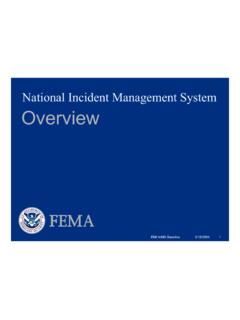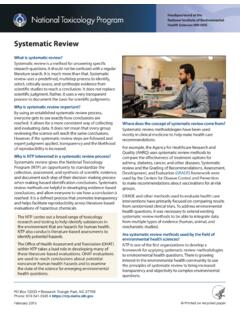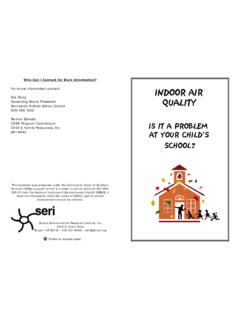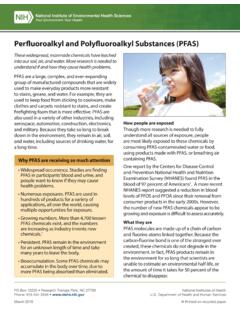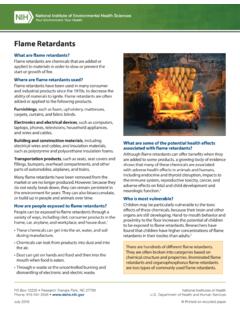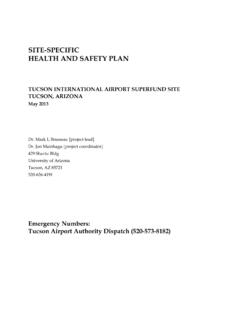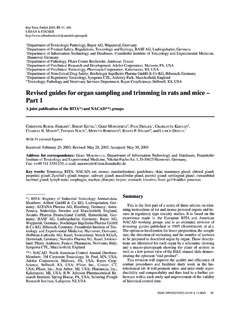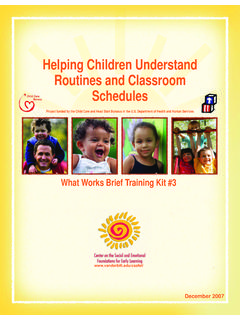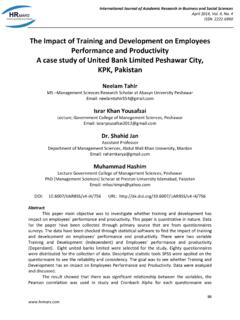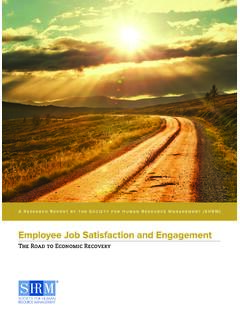Transcription of Quality assurance and training evaluation
1 training Program Quality assurance and evaluation Best Practices for Worker training Foundations Minimum Criteria Document ( Appendix E) Cooperative Agreement Requirements Awardee Evaluations Minimum Criteria Document Suggested Program Quality Control Criteria 1. training Plan 2. Program Management 3. Facilities and Resources 4. Quality Control and evaluation 5. Students 6. Institutional Environment and Administrative Support Quality Control and evaluation Advisory Committee and/or Outside Reviewers for overall policy guidance Adequate and appropriate Quality control and evaluation program to account for .. Instructor Performance Course evaluation for improvement Student evaluations Key evaluation Questions Quality and appropriateness of.
2 Program objectives (clarity and achievement) Facilities and staff Course material and mix of classroom andhands-on training Assessment of program strengths and weaknesses and needed improvements Cooperative Agreements NIEHS Stewardship and Oversight Roles Guiding Language for Quality assurance and evaluation NIEHS - Review Panel - team of outside experts and agency staff Awardees Lead responsibility in Quality control and internal evaluation Established own evaluation systems Cooperative Agreement Requirements Independent Board of Advisors Appropriate training and expertise to evaluate and oversee the proposed worker training program Formal
3 Quality Control and evaluation Plan Different forms depending on the the nature of the student population and awardee s program culture Why Evaluate Use positive feedback to build and expand programs Learn how to improve programs Determine need of additional training Document learning, confidence building and workplace changes Accountability (legal/program requirements) Multi-Program evaluation : A Descriptive Review February 1996 Review of over 50 awardee evaluation reports and 13 grant related journal articles and publications Used in overall program review Awardee Evaluations - Many Forms Focus on individuals and groups Qualitative (how and why) and quantitative (how much and how many) Descriptive (non-experimental designs) and trying to infer cause (quasi experimental designs)
4 Awardee Evaluations Focus Student perceptions of training Many thousands of positive student ratings Course materials Perceptions of usefulness Post- training use Knowledge, skills and decision-making Student self-assessments Testing and performance assessments Awardee Evaluations Focus Changes in awareness, concerns and attitudes Improvements in post- training response actions to HAZMAT incidents Changes in personal protective practices Systematic changes in worksite programs, policies, preparedness and equipment Catalyzing of additional site-based training training and sharing of information An evaluation of the NIEHS WETP - External Panel Report Not only has the NIEHS grant program provided training to hundreds of thousands of workers, managers and health and safety professionals, it has also made a substantial contribution to a more systematic, analytical and scientific approach to training program development , delivery and evaluation in terms of advancing the state of the art.
5 December 28, 1995 Resource Guide for Evaluating Worker training Purposes To provide both general and specific step by step guidance for both experienced and novice evaluators on how to design and carry out an evaluation To provide examples of evaluation instruments Resource Guide Content evaluation overview Special challenges to an evaluation team evaluation methods Annotated bibliography evaluation instruments (for off-the shelf use or adaptation) evaluation : Building the Capacity to Learn The Self-Sufficiency Research and evaluation Project (SREP) A Participatory evaluation Model SREP Partners AFSCME - American Federation of State, County and Municipal Employees with the University of Massachusetts Lowell PACE - Paper, Allied Industrial, Chemical and Energy Workers International Union with the Labor Institute and New Perspectives Consulting Group UAW - United Auto Workers with University of Michigan SREP - A Multi-Organizational Collaborative Three partners union-based occupational safety and health education programs Team-based composed of worker-trainers.
6 Program staff and/or evaluators SREP Overview Workshops Team evaluation Projects Research and evaluation Overview Develop and refine evaluation Introduction to Program Theories questions and designs May 1998 Developing evaluation Plans Refine data collection plans , Gathering and Analyzing Data begin data and analysis Aug 1998 Developing Meaning and Ongoing data collection, analysis Promoting the Use of Findings and report generation Jan 1999 Collective Reflections Develop program diffusion, Developing Lessons Learned prepare lessons learned report May 1999 Description of SREP Team Projects School district: Short survey and focus group (AFSCME) Municipality: Pilot individual interviews (AFSCME) Oil Refinery: In-plant labor management refinery team use of Charting How Your Program Works: and monitoring new safety and health initiative (PACE) Project Description (continued) Program-Wide Worker understanding of systems of safety card sort focus group (PACE) Workplace Impact phone interviews (UAW) Week-long training Conference Quick feedback from and back to training program participants (UAW) ModelofWorker-Led,Team based Participatory evaluation 1.
7 Builds a community united in a shared commitment to the rights of all workers to safe and healthy workplaces. 2. Actively involves workers in all aspects of evaluation . 3. Is a collective effort within and among partner organizations that draws upon each other s insights, strengths and experiences Model (continued) 4. Understands evaluation as a process of continuous learning, rather than being an end product 5. Provides important ways to measure and document program successes. 6. Recognizes the importance of identifying program values and goals to guide evaluations. Worker-Led, Team-Based evaluation Traditional Participatory Who: Who: evaluation consultant, program Team of worker trainers, trainers, evaluation consultant, administrator program administrator and staff What they do: What they do: Consultant designs, conducts, Team decides evaluation focus, analyzes and writes report design, data collection Worker trainers and trainers instruments, analysis, etc.
8 May distribute and collect Consultant may provide more evaluation forms hands-on work while those internal to program provide Consultant recommends ideas and feedback changes and future directions Team reflects on findings and for programs decides implications for future program directions Worker-Led, Team-Based evaluation (continued) Traditional Participatory When: When: At the end of project Throughout project How/Who: How/Who: Variety of formats formal Formal written report for written reports, group activities, program administrators, newsletters for worker funders trainers, program administrators, funders, staff Use: Use: To make judgments Learn how program works to guide ongoing improvements Expand original learning SREP Is Ongoing Beginning May 30 SREP partners will begin a new round of three-day workshops that will involve participants in training , planning and organizing to carry out participatory evaluations of their programs We welcome inquiries about joining us

